Births
| | This section is empty. You can help by adding to it. (June 2023) |
| Millennium: | 1st millennium BC |
|---|---|
| Centuries: | |
| Decades: | |
| Years: |
| 746 BC by topic |
| Politics |
|---|
| Categories |
| Gregorian calendar | 746 BC DCCXLV BC |
| Ab urbe condita | 8 |
| Ancient Egypt era | XXV dynasty, 7 |
| - Pharaoh | Piye, 7 |
| Ancient Greek era | 8th Olympiad, year 3 |
| Assyrian calendar | 4005 |
| Balinese saka calendar | N/A |
| Bengali calendar | −1338 |
| Berber calendar | 205 |
| Buddhist calendar | −201 |
| Burmese calendar | −1383 |
| Byzantine calendar | 4763–4764 |
| Chinese calendar | 甲午年 (Wood Horse) 1951 or 1891 — to — 乙未年 (Wood Goat) 1952 or 1892 |
| Coptic calendar | −1029 – −1028 |
| Discordian calendar | 421 |
| Ethiopian calendar | −753 – −752 |
| Hebrew calendar | 3015–3016 |
| Hindu calendars | |
| - Vikram Samvat | −689 – −688 |
| - Shaka Samvat | N/A |
| - Kali Yuga | 2355–2356 |
| Holocene calendar | 9255 |
| Iranian calendar | 1367 BP – 1366 BP |
| Islamic calendar | 1409 BH – 1408 BH |
| Javanese calendar | N/A |
| Julian calendar | N/A |
| Korean calendar | 1588 |
| Minguo calendar | 2657 before ROC 民前2657年 |
| Nanakshahi calendar | −2213 |
| Thai solar calendar | −203 – −202 |
| Tibetan calendar | 阳木马年 (male Wood-Horse) −619 or −1000 or −1772 — to — 阴木羊年 (female Wood-Goat) −618 or −999 or −1771 |
| | This section is empty. You can help by adding to it. (June 2023) |

Assyria was a major ancient Mesopotamian civilization which existed as a city-state from the 21st century BC to the 14th century BC, then to a territorial state, and eventually an empire from the 14th century BC to the 7th century BC.

The Kingdom of Judah was a Semitic-speaking kingdom of the Southern Levant during the Iron Age. Centered in the highlands of Judea, the kingdom's capital was Jerusalem. Jews are named after Judah and are primarily descended from it.

The 7th century BC began the first day of 700 BC and ended the last day of 601 BC.

Babylonia was an ancient Akkadian-speaking state and cultural area based in the city of Babylon in central-southern Mesopotamia. It emerged as an Amorite-ruled state c. 1894 BC. During the reign of Hammurabi and afterwards, Babylonia was called "the country of Akkad", a deliberate archaism in reference to the previous glory of the Akkadian Empire. It was often involved in rivalry with the older state of Assyria to the north and Elam to the east in Ancient Iran. Babylonia briefly became the major power in the region after Hammurabi created a short-lived empire, succeeding the earlier Akkadian Empire, Third Dynasty of Ur, and Old Assyrian Empire. The Babylonian Empire rapidly fell apart after the death of Hammurabi and reverted to a small kingdom.

Tiglath-Pileser III, was the king of the Neo-Assyrian Empire from 745 BC to his death in 727. One of the most prominent and historically significant Assyrian kings, Tiglath-Pileser ended a period of Assyrian stagnation, introduced numerous political and military reforms and more than doubled the lands under Assyrian control. Because of the massive expansion and centralization of Assyrian territory and establishment of a standing army, some researchers consider Tiglath-Pileser's reign to mark the true transition of Assyria into an empire. The reforms and methods of control introduced under Tiglath-Pileser laid the groundwork for policies enacted not only by later Assyrian kings but also by later empires for millennia after his death.

Shalmaneser III was king of the Neo-Assyrian Empire from the death of his father Ashurnasirpal II in 859 BC to his own death in 824 BC.
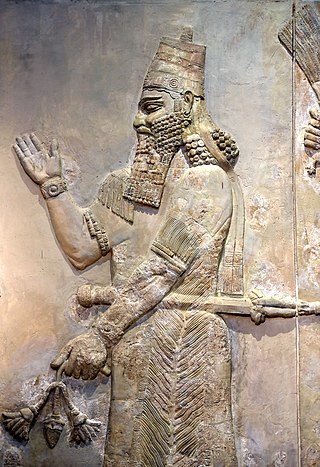
Sargon II was the king of the Neo-Assyrian Empire from 722 BC to his death in battle in 705. Probably the son of Tiglath-Pileser III, Sargon is generally believed to have become king after overthrowing Shalmaneser V, probably his brother. He is typically considered the founder of a new dynastic line, the Sargonid dynasty.
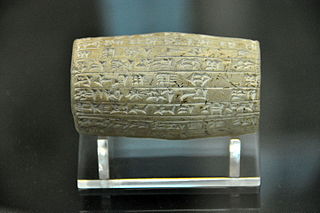
Nabopolassar was the founder and first king of the Neo-Babylonian Empire, ruling from his coronation as king of Babylon in 626 BC to his death in 605 BC. Though initially only aimed at restoring and securing the independence of Babylonia, Nabopolassar's uprising against the Neo-Assyrian Empire, which had ruled Babylonia for more than a century, eventually led to the complete destruction of the Assyrian Empire and the rise of the Neo-Babylonian Empire in its place.

Ashurbanipal was the king of the Neo-Assyrian Empire from 669 BCE to his death in 631. He is generally remembered as the last great king of Assyria. Inheriting the throne as the favored heir of his father Esarhaddon, Ashurbanipal's 38-year reign was among the longest of any Assyrian king. Though sometimes regarded as the apogee of ancient Assyria, his reign also marked the last time Assyrian armies waged war throughout the ancient Near East and the beginning of the end of Assyrian dominion over the region.
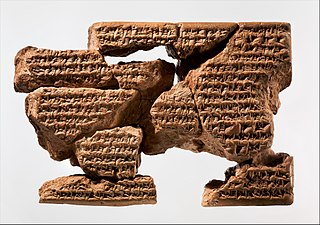
Sîn-šar-iškun was the penultimate king of Assyria, reigning from the death of his brother and predecessor Aššur-etil-ilāni in 627 BC to his own death at the Fall of Nineveh in 612 BC.
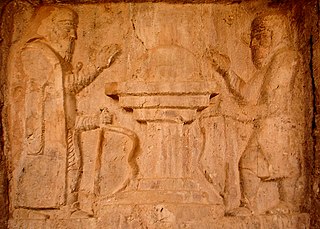
Cyaxares was the third king of the Medes.
Ashur-nirari V was the king of the Neo-Assyrian Empire from 755 BC to his death in 745 BC. Ashur-nirari was a son of Adad-nirari III and succeeded his brother Ashur-dan III as king. He ruled during a period of Assyrian decline from which few sources survive. As such his reign, other than broad political developments, is poorly known.

Sîn-šumu-līšir or Sîn-šumu-lēšir, also spelled Sin-shum-lishir, was a usurper king in the Neo-Assyrian Empire, ruling some cities in northern Babylonia for three months in 626 BC during a revolt against the rule of the king Sîn-šar-iškun. He was the only eunuch to ever claim the throne of Assyria.
Madyes was a Scythian king who ruled during the period of the Scythian presence in West Asia between 659–625 BCE. Madyes was the son of the Scythian king Bartatua and the Assyrian princess Šērūʾa-ēṭirat, and was a close ally of the Neo-Assyrian Empire whose king Ashurbanipal was his uncle. His reign brought Scythian power to a peak and saw extensive Scythian ("Iškuza") settlement in West Asia.

The Neo-Babylonian Empire or Second Babylonian Empire, historically known as the Chaldean Empire, was the last polity ruled by monarchs native to Mesopotamia. Beginning with the coronation of Nabopolassar as the King of Babylon in 626 BC and being firmly established through the fall of the Neo-Assyrian Empire in 612 BC, the Neo-Babylonian Empire was conquered by the Achaemenid Persian Empire in 539 BC, marking the collapse of the Chaldean dynasty less than a century after its founding.

The Neo-Assyrian Empire was the fourth and penultimate stage of ancient Assyrian history and the final and greatest phase of Assyria as an independent state. Beginning with the accession of Adad-nirari II in 911 BC, the Neo-Assyrian Empire grew to dominate the ancient Near East throughout much of the 8th and 7th centuries BC, becoming the largest empire in history up to that point. Because of its geopolitical dominance and ideology based in world domination, the Neo-Assyrian Empire is by many researchers regarded to have been the first world empire in history. And through this, the Assyrian Empire influenced culturally, governmentally, and militarily on the empires of the ancient world, including the Babylonians, the Achaemenids, and the Seleucids. At its height, the empire was the strongest military power in the world and ruled over all of Mesopotamia, the Levant and Egypt, as well as portions of Anatolia, Arabia and modern-day Iran and Armenia.
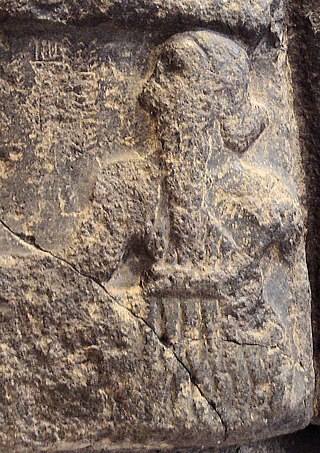
Sargon of Akkad, also known as Sargon the Great, was the first ruler of the Akkadian Empire, known for his conquests of the Sumerian city-states in the 24th to 23rd centuries BC. He is sometimes identified as the first person in recorded history to rule over an empire.
Aššur-uballiṭ II, also spelled Assur-uballit II and Ashuruballit II, was the final ruler of Assyria, ruling from his predecessor Sîn-šar-iškun's death at the Fall of Nineveh in 612 BC to his own defeat at Harran in 609 BC. He was possibly the son of Sîn-šar-iškun and likely the same person as a crown prince mentioned in inscriptions at the Assyrian capital of Nineveh in 626 and 623 BC.

The Medo-Babylonian conquest of the Assyrian Empire was the last war fought by the Neo-Assyrian Empire, between 626 and 609 BC. Succeeding his brother Ashur-etil-ilani, the new king of Assyria, Sinsharishkun, immediately faced the revolt of one of his brother's chief generals, Sin-shumu-lishir, who attempted to usurp the throne for himself. Though this threat was dealt with relatively quickly, the instability caused by the brief civil war may have made it possible for another official or general, Nabopolassar, to rise up and seize power in Babylonia. Sinsharishkun's inability to defeat Nabopolassar, despite repeated attempts over the course of several years, allowed Nabopolassar to consolidate power and form the Neo-Babylonian Empire, restoring Babylonian independence after more than a century of Assyrian rule. The Neo-Babylonian Empire, and the newly-formed Median Empire under King Cyaxares, then invaded the Assyrian heartland. In 614 BC, the Medes captured and sacked Assur, the ceremonial and religious heart of the Assyrian Empire, and in 612 BC, their combined armies attacked and razed Nineveh, the Assyrian capital. Sinsharishkun's fate is unknown but it is assumed that he died in the defense of his capital. He was succeeded as king only by Ashur-uballit II, possibly his son, who rallied what remained of the Assyrian army at the city of Harran and, bolstered by an alliance with Egypt, ruled for three years, in a last attempt to resist the Medo-Babylonian invasion of his realm.

Nidin-Bel might have been a rebel king of Babylon who in the autumn of 336 BC and/or the winter of 336–335 BC attempted to restore Babylonia as an independent kingdom and end the rule of the Persian Achaemenid Empire in the region. The only known surviving reference which points to there being a ruler by this name in Babylon is the Uruk King List, which records rulers of Babylon from the 7th to 3rd centuries BC. In this list, the rule of Darius III, the last Achaemenid king, is immediately preceded by a fragmentary reference to Nidin-Bel.